Night Light Galaxy Projector Starry Sky Projector 360 Rotate Planetarium Lamp
Night Light Galaxy Projector Starry Sky Projector 360 Rotate Planetarium Lamp
Couldn't load pickup availability
Escape the Ordinary and Unwind Under a Breathtaking Cosmos with the 12-in-1 Galaxy Projector & Planetarium.
Do you crave a retreat from the everyday? Imagine transforming your space into a calming oasis filled with the twinkling magic of a starry night. The 12-in-1 Galaxy Projector & Planetarium isn't just for kids, it's an invitation for adults to unwind, reconnect with a sense of wonder, and create a truly unique atmosphere.
Here's why the 12-in-1 Galaxy Projector & Planetarium is the perfect addition to your home:
12 Breathtaking Display Options: Explore the wonders of the Solar System, travel to distant galaxies, and marvel at nebulas from the comfort of your home. Each film unveils a new astronomical marvel, sparking curiosity and a love for science.
Unwind After a Long Day: The calming nebula projections and gentle starry night effects create a peaceful ambiance, perfect for relaxation and stress relief.
A Multi-Sensory Escape: Project the wonders of the universe onto your ceiling, walls, or even the floor for a truly immersive experience.
Set the Mood for Any Occasion: Create a romantic atmosphere, liven up a party, or simply enjoy a mesmerizing light show – the customizable options cater to any mood.
More Than Just a Projector: This versatile device can be a conversation starter, a unique nightlight, or a mesmerizing backdrop for meditation or yoga.
High-Tech for the Home: Experience stunning clarity with the upgraded HD projection lens. Cover a massive area and support up to 5M projection distance and 134㎡ projection area. Perfect for decorating rooms.
Forget the generic nightlight: The 12-in-1 Galaxy Projector & Planetarium is a sophisticated way to elevate your home environment. Transform your space into a sanctuary for relaxation, ignite conversation, or simply marvel at the universe's beauty – all from the comfort of your couch.
Peaceful Ambiance: This projector operates silently, creating a calming atmosphere perfect for bedtime relaxation.
Treat yourself to a touch of wonder. Order your 12-in-1 Galaxy Projector & Planetarium today!
Product information:
Simple to Use, Perfect for All Ages
Light color: black and white (send 12sets of film)
Power supply: 10W
Power supply mode: USB
Additional features: Bluetooth
Intelligent control: Intelligent control is not supported
Installation mode: platform
Power port: TYPE-C
Input voltage: DC5V
Input current: DC2A
Number of lamp beads (PCS) : 1PCS
Light source color: white light
Maximum output power: 10W
Control mode: physical key control *3 (respectively for the on/key, timing setting key, speed setting key)
Focusing mode: According to the current projection definition, rotate the lens adjustment knob forward and backward to make the image projected to the projection surface clearer.
Projection method: film projection
Projected distance: 2-5m/ 6.56-16.4 ft.
Projection area: When the product is 3 meters away from the projection surface, the projection area is 12.5 square meters, and so on
Operating temperature:-20~50℃/-4~122°F
Storage temperature :-20~60 ° C /-4~140°F
Use environment: indoor dark environment use


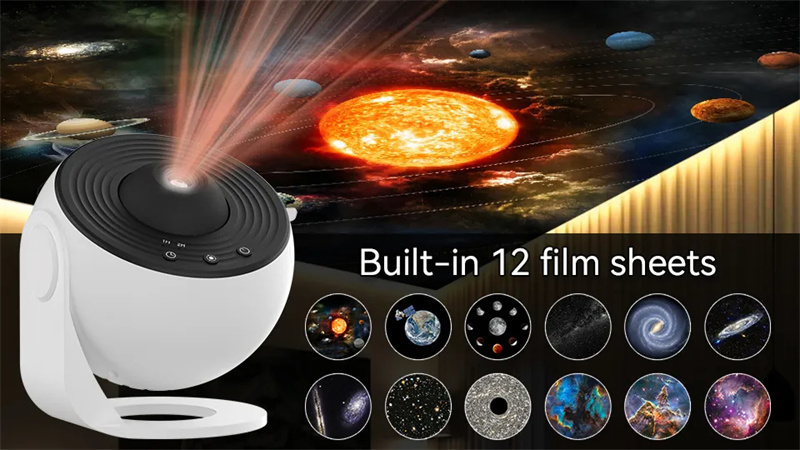
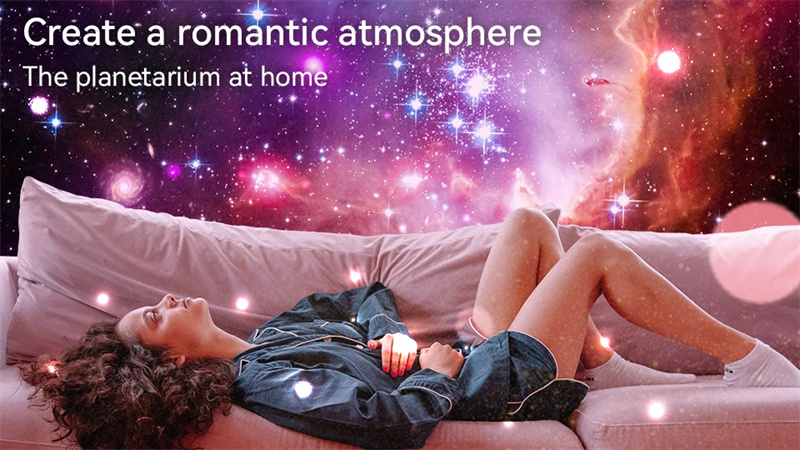

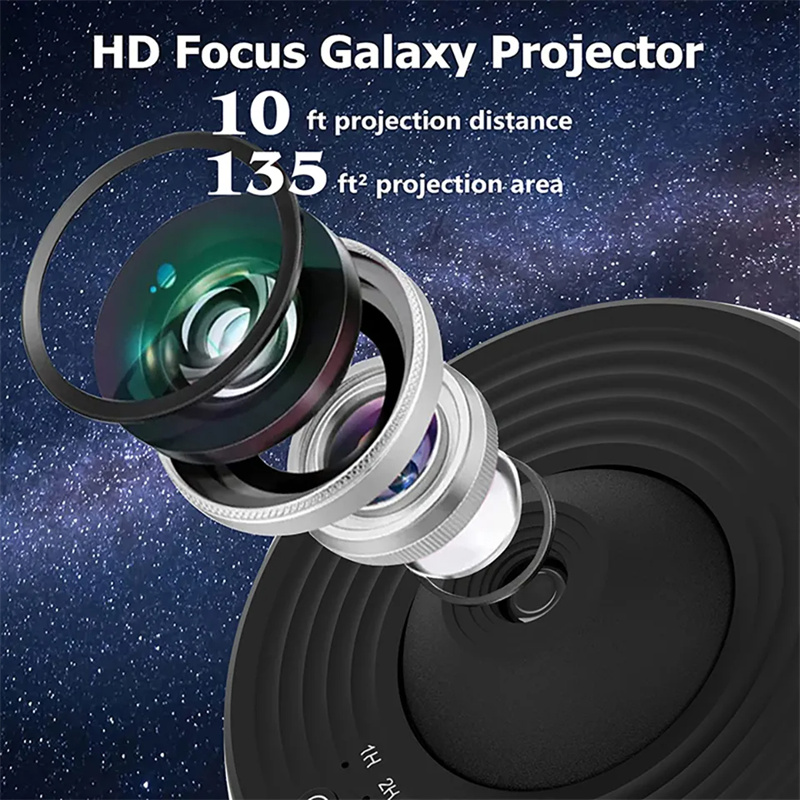
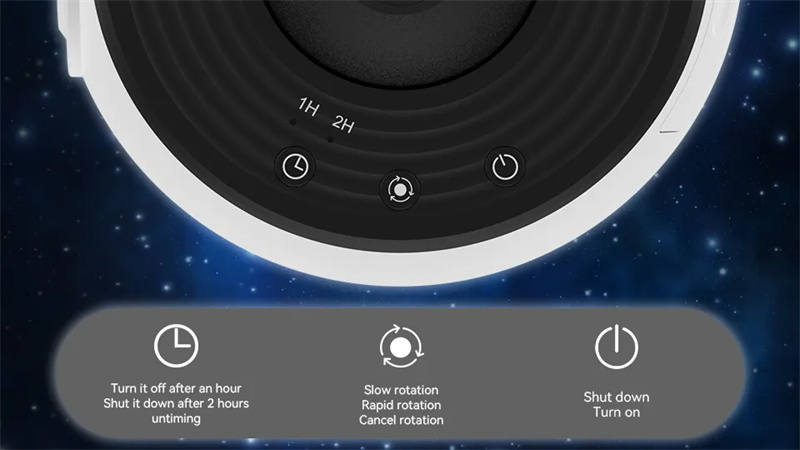
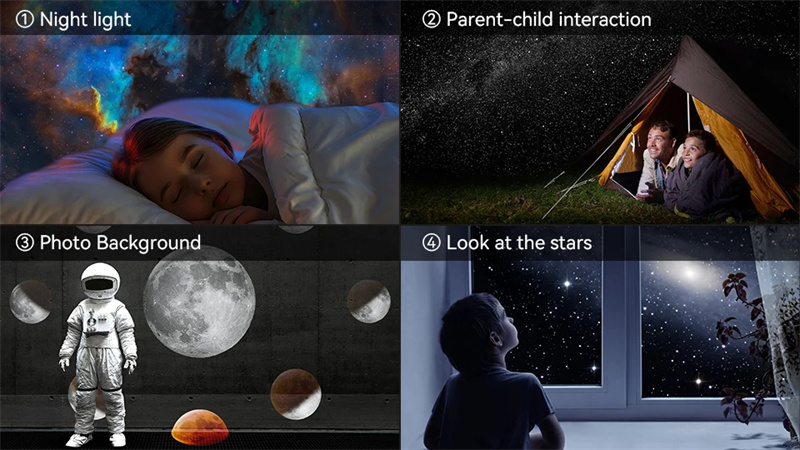

Fun fact about some of the different disks.
imagine this in your living room what a view.

Earth: Imagine floating in the vastness of space, gazing out from the windows of the International Space Station, and there it is our beautiful blue planet, Earth. Suspended like a jewel in the void, it's the third planet from the Sun, approximately 93 million miles (150 million kilometers) away. Earth has been our home for millennia, nurturing life with its rich ecosystems and diverse landscapes.
The Moon: Casting its silvery glow against the velvet darkness of space, the Moon has been a constant companion to Earth for billions of years. it's our Moon, a celestial dance partner that has orbited Earth for as long as we can remember. But it's more than just a pretty sight, the Moon plays a vital role in protecting Earth. Its gravitational pull helps stabilize our planet's axial tilt, which in turn regulates our climate. Additionally, the Moon acts as a cosmic shield, deflecting potentially hazardous meteoroids and asteroids from crashing into Earth's surface. It's a silent guardian, watching over us as we journey through the cosmos.
The Milky Way: Our galaxy, the Milky Way, stretches across the night sky like a celestial river of stars. Spanning approximately 100,000 light-years in diameter, it's a vast tapestry of billions of stars, planets, and cosmic wonders. The Milky Way has been captivating observers since ancient times, inspiring myths, legends, and scientific inquiry.
Andromeda Galaxy: With its spiral arms stretching out like cosmic tendrils, the Andromeda Galaxy is a breathtaking sight in the night sky. Located about 2.537 million light-years away from Earth, it's the closest spiral galaxy to our own Milky Way. First described in 964 AD by Persian astronomer Abd al-Rahman al-Sufi, Andromeda has captured the imagination of astronomers and stargazers alike.
NGC4302, a barred spiral galaxy, resides approximately 55 million light-years away in the constellation Coma Berenices. Discovered by the renowned astronomer William Herschel in 1784, this distant marvel captivates backyard astronomers despite its considerable distance. Within its cosmic embrace lie billions of stars, enveloped by sprawling star-forming regions and clusters that adorn its vibrant expanse. Distinct spiral arms elegantly wrap around a central bar structure, revealing the intricate dance of galactic dynamics. The study of NGC4302 offers astronomers invaluable insights into the mechanisms governing the formation and evolution of barred spiral galaxies across the vastness of the universe.
NGC4298, an unbarred spiral galaxy, accompanies NGC4302 in the constellation Coma Berenices. Discovered alongside its celestial neighbor by William Herschel in 1784, NGC4298 lacks the central bar structure found in its counterpart. Its graceful spiral arms extend directly from the galactic center, adorned with luminous clusters of stars, interlaced dust lanes, and regions teeming with the energy of active star formation. Situated within the sprawling Virgo Cluster of galaxies, spanning millions of light-years, NGC4298 contributes to our comprehension of the rich diversity and dynamic nature of spiral galaxies within vast cosmic communities. Observations of NGC4298 illuminate the intricate threads woven into the cosmic tapestry of the universe, offering glimpses into its mesmerizing complexity.
Hubble Deep Field: The Hubble Deep Field is a window into the distant universe, revealing thousands of galaxies scattered across the cosmos. Captured by the Hubble Space Telescope, this awe-inspiring image showcases the sheer scale and complexity of the universe. First observed in December 1995, the Hubble Deep Field has revolutionized our understanding of the cosmos and our place within it.
M60-ucd1: This ultra-compact dwarf galaxy resides within the Virgo Cluster, approximately 54 million light-years away from Earth. Discovered in 2013 by astronomers using the Hubble Space Telescope, M60-ucd1 offers valuable insights into the formation and evolution of galaxies in the universe.
North America Nebula: Stretching across the night sky like a celestial masterpiece, the North America Nebula is a sprawling cloud of gas and dust. Located approximately 1,600 light-years away from Earth in the constellation Cygnus, it's a stellar nursery where new stars are born. Discovered in the 18th century, the North American Nebula continues to captivate astronomers and amateur stargazers alike.
Mystic Mountain: Rising like a towering spire amidst the cosmic mist of the Carina Nebula, Mystic Mountain is a testament to the beauty and power of stellar formation. This iconic structure, captured by the Hubble Space Telescope, serves as a reminder of the dynamic and ever-changing nature of the universe.
Small Magellanic Cloud: Floating like a ghostly apparition in the southern sky, the Small Magellanic Cloud is a dwarf galaxy located approximately 200,000 light-years away from Earth. Known to indigenous peoples in the Southern Hemisphere for centuries, it's a celestial marvel that continues to inspire wonder and curiosity.

























